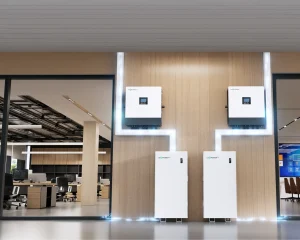With the increasing demand for energy, businesses and homeowners are turning toward renewable sources. Solar systems are the best to meet energy needs while ensuring sustainability.
When you are making an investment in a solar system, you surely want to know how profitable it will be. Understanding the return on investment (ROI) helps you determine how much you’ll save over time. This blog post will help you calculate the ROI of a solar system. So, let’s get into it.
What is The ROI for Solar System?

The ROI of a solar system measures how much financial return you gain from its installation compared to its total cost. It is expressed as a percentage. It helps determine how long it will take for your solar panels to pay for themselves through energy savings.
Calculating The ROI for Solar System?
Calculating the ROI of a solar system involves the following steps:
Determine Total Installation Cost
The first step in determining whether your solar system is profitable or not is calculating the installation cost. This includes the purchasing price of solar panels, inverters, mounting structures, wiring, and other hardware. It also includes permitting expenses and labor charges.
These combined expenses represent your upfront investment. Knowing accurate figures is crucial for accurately calculating your return.
Account for Incentives
In several regions, governments and local authorities offer financial incentives for solar system installation. It encourages citizens to use renewable energy. These may include tax credits, grants, or rebates.
These incentives significantly minimize the initial investment. However, such incentive programs vary by region and can change over time. That’s why you need to check them on relevant sites before investing.
Calculate Annual Energy Savings
Now, determine how much you will save on electricity each year. This step enables you to understand the financial benefits of opting for solar energy.
You can estimate the energy savings by determining the annual energy production of your solar system. The energy production depends on its capacity, sunlight duration in your region, and the system’s efficiency.
Once you have estimated these aspects, multiply the value of energy saving by your local electricity rate. It will give you annual energy savings.
Some systems produce excess energy that can be sold back to the grid. Keep an eye on your system to learn about excess energy. It’s the additional income you can generate with your solar system.
Estimate Maintenance Costs
Solar panels are sensitive and require regular maintenance. It includes periodic cleaning, inspection, insurance, and inverter replacement after 10–15 years of use.
Without proper maintenance, your solar panel will gradually lose efficiency. Dust, debris, and bird droppings can block sunlight from reaching the panels. It can reduce the energy out.
Estimating these expenses ensures you have a realistic view of ongoing costs. Deducting them from your total savings helps give a more accurate ROI value. It also prevents you from overestimating your profit.
Pick an Analysis Period
Picking the right time frame for calculation is another crucial measure. Choosing a too short analysis duration may not fully capture the long-term benefits. A too-long period can offer you a better opportunity to evaluate the outputs. However, you have to consider different variables, like hanging energy rates and system degradation. Therefore, it’s wise to base your calculations on the manufacturer’s warranty period for reliability.
Calculate The ROI of the Solar System
Once you have determined the installation cost and annual energy savings, you can calculate the ROI of the solar system. In the first step, calculate the net benefit. For that, multiply that amount by the total number of years in your analysis period. It will give you the savings over the years.
From this figure, subtract your total installation costs. You’ll get the net benefit. It represents the total financial gain your solar system provides over its lifetime.
Now that you have net benefit, you can calculate the ROI. Divide net benefit by total installation costs and multiply by 100. Use the following formula:
ROI = (Net Benefit ÷ Total Installation Cost) × 100
This gives you a percentage value that indicates how efficiently your investment generates profit. A higher ROI means more financial benefit.
Calculate the Payback Period
In the next step, you need to calculate the payback period. It is a measure of the duration it will take for your energy savings to cover your initial costs. To find this, divide your net installation cost by your annual savings.
This indicates that after a certain time, your system will start generating free electricity. At that time, your investment will turn into profit.
Factors that Affect The ROI of a Solar System

Various factors influence the ROI of a solar system. Understanding these helps you make smarter financial decisions. Let’s take a look.
Cost of Electricity
The cost of electricity in your region is a major factor that influences your solar ROI. If the electricity cost is high, you’ll leverage a faster payback on your investment. In contrast, if electricity rates are low, your investment will still pay back. However, it may take longer to recover your investment.
Sun Hours
The duration of sunlight significantly impacts your ROI of your solar system. If you are in a region where sun hours are longer and consistent, your solar system will generate more electricity. It leads to higher savings and faster payback.
In contrast, if you live in an area with short sun hours and frequent cloud cover, you may see reduced energy output.
Product Warranty
Product warranties are vital in determining your system’s ROI. A long warranty ensures protection against defects, performance drops, or component failures. It reduces the likelihood of unexpected repair or replacement costs.
Most high-quality solar panels come with a warranty of 20 to 25 years. It provides financial security, helping maintain stable returns.
Conclusion
Solar systems are a fantastic investment. They allow you to generate eco-friendly and cheaper electricity. By calculating the ROI of a solar system, you can estimate its profitability. You need to carefully estimate everything to get a realistic picture of payback time and long-term savings. So, calculate the ROI of your solar system and make an informed decision.

